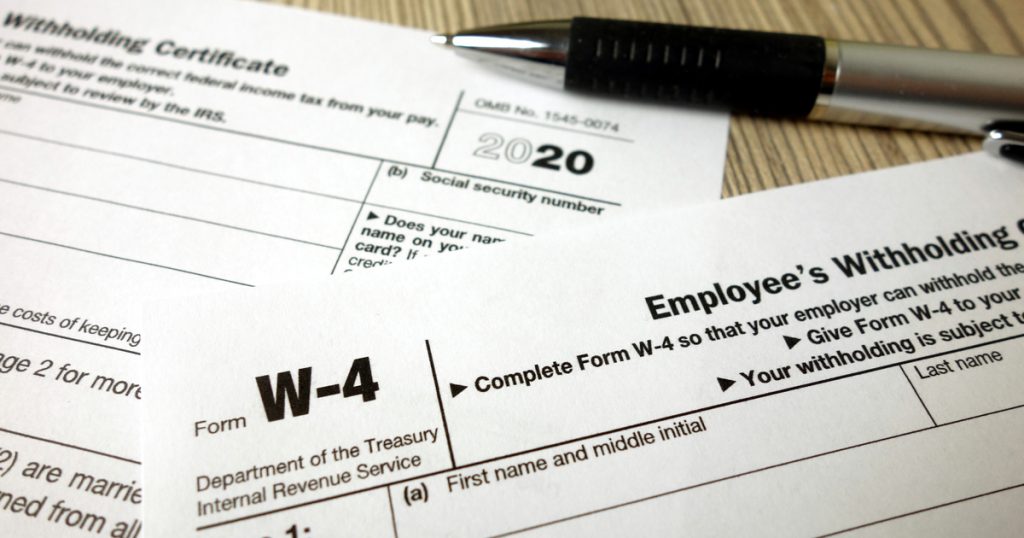Confused About The New 2020 W-4? Here’s What You Need to Know

As an employer, a Form W-4 tells you how much to withhold from each employee’s paycheck. That’s what it is using a single sentence. The form’s official title is “Employee’s Withholding Certificate.” The IRS created the form for your employees to fill out. You can then use the information to calculate payroll taxes and then send that money to state and federal governments.
The Purpose of a Form W-4
Each time you give your employees a paycheck, some of the money they earned will go to the IRS. This is why the IRS created a form W-4, and it is why you make your employees complete this form before they start working. If they want to get paid, they will need to fill out this form.
At the end of the year, you will give all your employees a W-2. This documents how much they made in comparison to how much they withheld.
Because you don’t want your employees to have too much or too little withheld, you can point them to the Tax Withholding Estimator run by the IRS.
Why Is There a New 2020 W-4?
When people filed taxes during the 2019 tax season, many people who had received refunds in previous years were now having to pay taxes. Instead of receiving checks, they had to write them.
What was so shocking was that most of the people hadn’t changed jobs or had changed their status/withholding amount.
So what changed?
There was a large tax reform law in 2017 which, ultimately, reduced tax rates, doubled the standard deduction, and increased the child credit. Presumably, all of these things would lower the tax bill—which is entirely true.
But the IRS lowered the amount of taxes withheld to reflect the law changes. They just didn’t withhold enough. Even though taxes were lower and people kept more of their money, they had to write checks to the government to make up for what hadn’t been withheld.
The new 2020 W-4 was a means to rectify this.
Filling Out a New 2020 W-4
You can download the new 2020 W-4 here.
In 2020, there were a few changes made to the Form W-4, and we will go over them here.
No more allowances – Before the new 2020 W-4 was created, your employees would have to choose their allowances. More allowances used to mean less taxes withheld. If they chose the wrong number of allowances, then they’d pay at the end to make up for it.
Now, your employees don’t choose the number of allowances. Instead, they claim their filing status, family income, number of dependents, and planned tax deductions. With that, your company will do the necessary calculations for the proper withholdings.
Their Old Forms Will Suffice – Previous Form W-4s can stand as they are. If your employees want to fill out the new one, they may do so through their Human Resources department, or through you depending the size of your company.
Is This Form Easier? – It depends. If you have an employee who is a single person without dependents who isn’t seeking tax credits or exemptions, then they don’t have to do much outside of providing their social security number. That’s about all they’ll have to add.
Otherwise, they will need to provide specific information about their spouse, his/her income, their dependents, tax credits, and exemptions.
The IRS Can Help – Changes like these may cause confusion, and there are different ways where this form can cause a disruption for your employees. Working multiple jobs and accounting for a spouse’s income is different; although accounting for tax credits can be easier, there is still room for error: for example, your employees should not include their standard deduction with their additional deductions.
Again, to avoid some of these potential pitfalls, they can use the Tax Withholding Estimator. Ideally, whatever they are going to owe, that want that amount withheld by you. Giving too much is giving the government an interest-free loan, and giving too little will result in them having to pay money that they may not have properly accounted for.
Keep It Organized
After you have a W-4 from your employees, let us do the rest. If you use 123Paystubs, We can calculate all of your taxes and withholdings for you—accurately and quickly.
Try 123PayStubs Today!


Leave a Comment